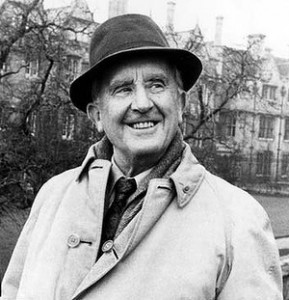Partially hidden behind the show title on one of the new Amazon Prime The Lord of the Rings–The Rings of Power posters is a hammer handle bearing Cirth runes. They appear to say “AWAKE SLEEPING STONE”, which is appropriate since the poster seems clearly to portray a Dwarf, hands permeated with gold dust.

Perhaps the meaning behind these words can be discovered in The Silmarillion. When Aulë, one of the Valar, created the Dwarves in secret “in a hall under the mountains in Middle-earth”, he preempted Eru Ilúvatar’s desire that the Elves, the Firstborn of his design, be the first sentient beings in Middle-earth. Instead of destroying Aulë’s creations, Ilúvatar granted them life, but not until after the Elves were awakened. Ilúvatar tells Aulë:
“They shall sleep now in the darkness under stone, and shall not come forth until the Firstborn have awakened upon Earth; and until that time thou and they shall wait, though long it may seem. But when the time comes, I will awaken them…”
J.R.R Tolkien, The Silmarillion, Of Aulë and Yavanna
Or it could be that the inscription on the hammer refers to the Dwarves’ love of delving deep under the earth, awakening the stone to its potential to become vast and glorious halls, such as Menegroth, the realm of King Thingol and Queen Melian, and Moria, or as it is called in the Dwarven tongue, Khazad-dûm.
In regards to the runes that appear on the hammer, they are a system of writing called the Cirth, or the Angerthas. They were created by Tolkien and appear in a chart in the Lord of the Rings in ‘Appendix E: Writing and Spelling’. Historically, runes were used across Northern Europe during the Middle Ages by the Anglo-Saxons and Vikings. Tolkien borrowed from these sources and others to create his own unique set of runes. In Tolkien’s legendarium, the origins of the Dwarven runes as we know them date back to the Sindar and Noldor Elves, and the Dwarves did not come to learn them until the beginning of the Second Age, which fits in with the show’s timeline. The Elves later abandoned Cirth for Tengwar, used commonly to write Quenya and Sindarin. Cirth only represented the sounds of Sindarin, and were primarily used for engraving into stone, metal, or wood, the reason for the straight edges and angles of the letters. The Dwarves of Moria added to and expanded the Angerthas to serve their own language and purposes.
In translating the poster, there were two runes that confused the meaning at first. The first was the rune used for “ng” in “Sleeping”. The poster uses the rune for “nj” instead of “ng”. According to the LotR appendices, the “ng” rune was one of the newer cirth introduced by the Dwarves of Moria, though it does not say at what date. It does say “This Angerthas Moria is represented in the tomb-inscription.” Assuming this references Balin’s Tomb, the “ng” rune might not have been in popular usage until later than the series may portray. The second thing that tripped me up was the rune used for the silent “e” in “Awake” and “Stone”. The symbol for the silent “e” is given a value of “*” on the chart in the appendices, and it was only through further research that I was able to confirm the corresponding letter and sound.
It’s really wonderful to return to Arda! There is so much to look forward to when The Rings of Power airs this fall – and even sooner if these posters are any indication.





 What do Game of Thrones’ Dothraki, Avatar’s Na’vi, Star Trek’s Klingon and LOTR’s Elvish have in common? They are all fantasy constructed languages, or conlangs.
What do Game of Thrones’ Dothraki, Avatar’s Na’vi, Star Trek’s Klingon and LOTR’s Elvish have in common? They are all fantasy constructed languages, or conlangs.  The Fifth International Conference on J.R.R. Tolkien’s Invented Languages,
The Fifth International Conference on J.R.R. Tolkien’s Invented Languages,